Samsung Galaxy S 5 Review
by Anand Lal Shimpi & Joshua Ho on April 8, 2014 12:00 AM EST- Posted in
- Smartphones
- Samsung
- Mobile
- Galaxy S 5
CPU Performance
The Galaxy S 5 marks the second Snapdragon 801 based device we've reviewed at AnandTech, the first being HTC's M8. I've gone through the Snapdragon 801 in depth already, but we're basically dealing with a reasonable upgrade to Snapdragon 800 on an improved 28nm HPm process. The bulk of the improvements impact GPU and ISP performance, but the SoC is just better overall. GS5 owners are lucky as all versions of the device that use Qualcomm silicon feature the MSM8974AC v3 SKU, which includes four 2.5GHz Krait 400 cores and a 578MHz Adreno 330 GPU.
| Snapdragon 800/801 Breakdown | ||||||||||
| SoC Version | Model | Max CPU Frequency | Max GPU Frequency | ISP | eMMC | DSDA | Memory IF | |||
| MSM8974VV | v2 | S800 | 2.2GHz | 450MHz | 320MHz | 4.5 | N | 800MHz | ||
| MSM8974AA | v2 | S800 | 2.3GHz | 450MHz | 320MHz | 4.5 | N | 800MHz | ||
| MSM8974AB | v2 | S800 | 2.3GHz | 550MHz | 320MHz | 4.5 | N | 933MHz | ||
| MSM8974AA | v3 | S801 | 2.3GHz | 450MHz | 320MHz | 5.0 | Y | 800MHz | ||
| MSM8974AB | v3 | S801 | 2.3GHz | 578MHz | 465MHz | 5.0 | Y | 933MHz | ||
| MSM8974AC | v3 | S801 | 2.5GHz | 578MHz | 465MHz | 5.0 | Y | 933MHz | ||
Although Samsung was the first major OEM to be caught cheating in Android benchmarks, it appears to have completely abandoned the practice with the Galaxy S 5's shipping software. Not only was I unable to find any evidence of the old cheats, I couldn't find any evidence of HTC's new subtle cheating either. The Galaxy S 5 appears to be clean as far as I can tell. Kudos to Samsung on doing the right thing, and I hope all other OEMs take this as a sign to stop the silliness.
For our performance tests I turned to our usual suite of browser and native applications. If there's one obvious takeaway from our CPU tests it's that despite having faster silicon than HTC's M8, the GS5 isn't always faster. I believe this has more to do with thermals than anything else. HTC's metal chassis is able to do a better job of dissipating heat than the GS5's plastic chassis. I don't believe there's a substantial impact on user experience, but it's interesting to note how choice in materials can have a performance impact like this.
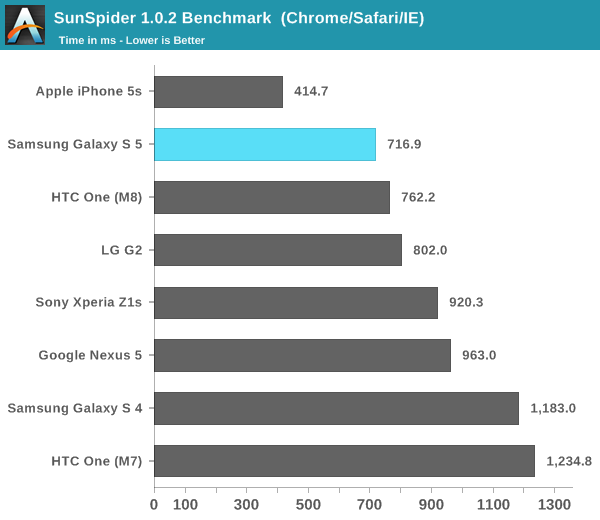
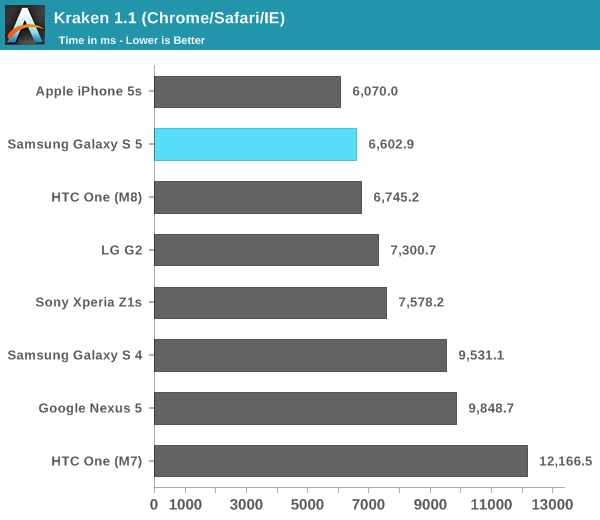
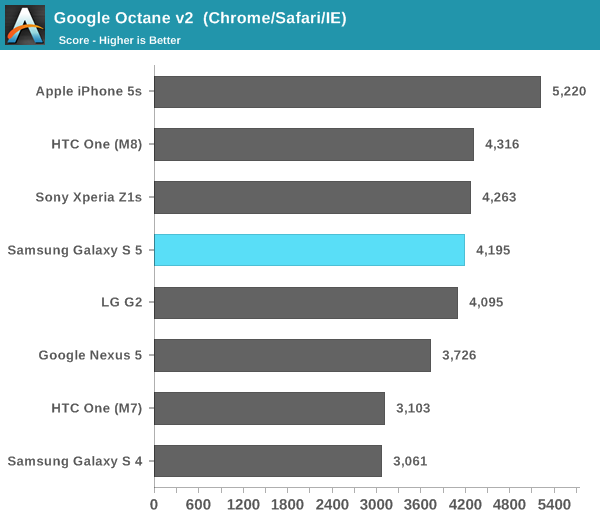
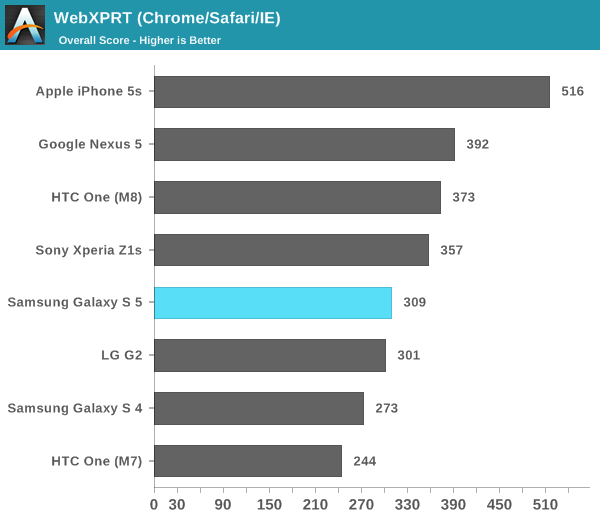
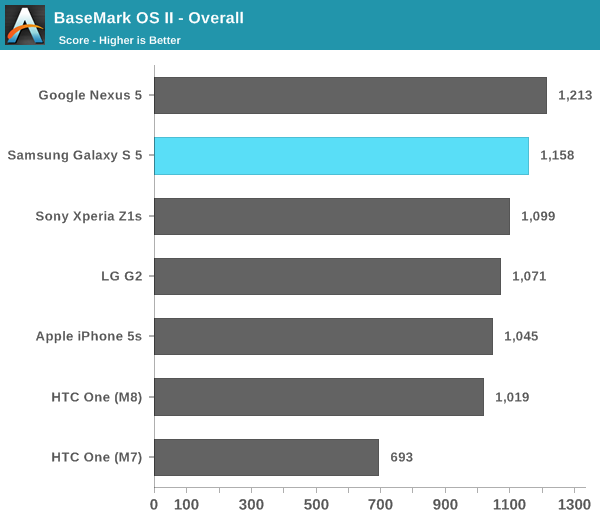
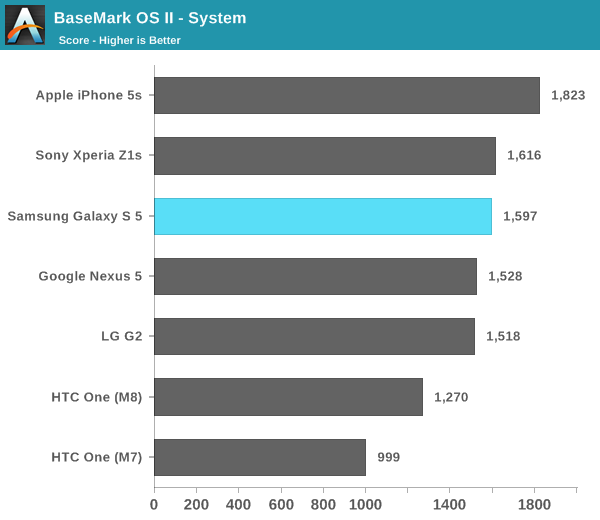
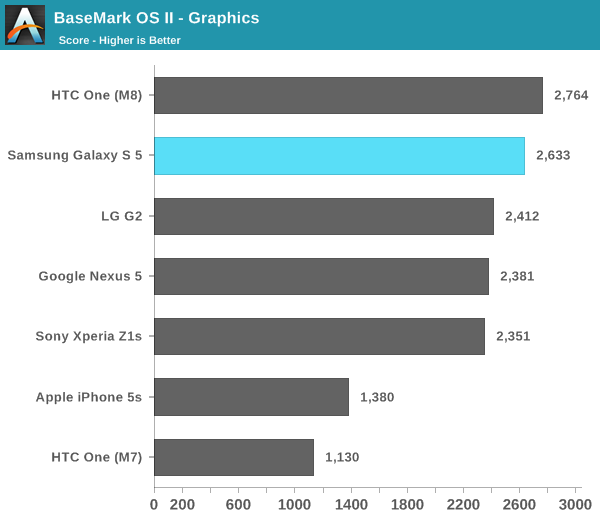

GPU Performance
GPU performance remains where we see the biggest benefit from Snapdragon 801 vs. 800, and since the GPU gains are almost entirely due to frequency scaling it's not too surprising that the M8 pulls ahead of the GS5 here in most cases.
There aren't any surprises here. The Adreno 330 in the Galaxy S 5 is more than capable of driving the device's 1080p display both in current and near term future 3D games.
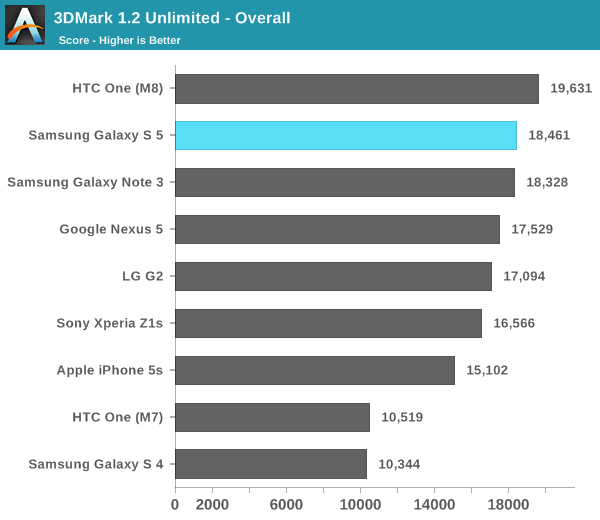
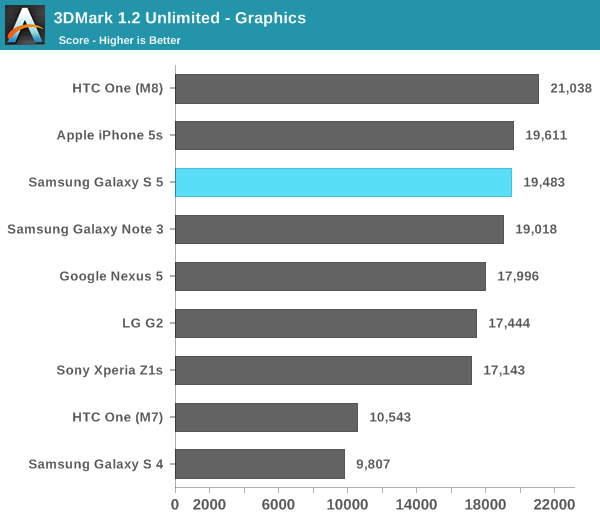
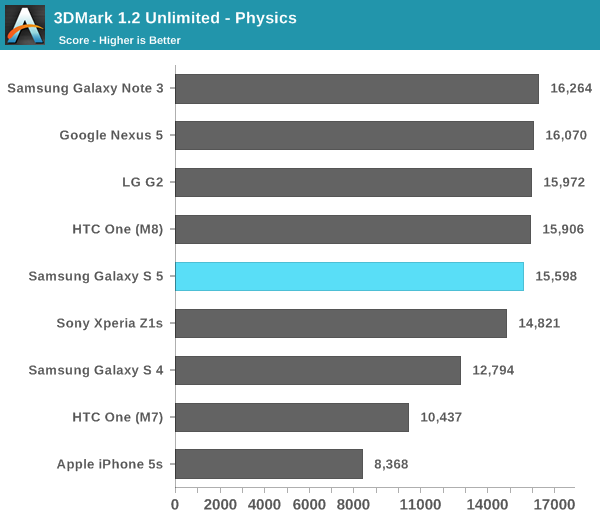
BaseMark X 1.1
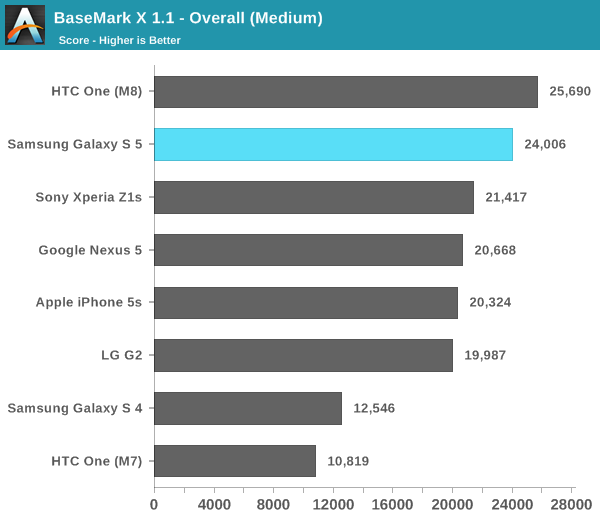

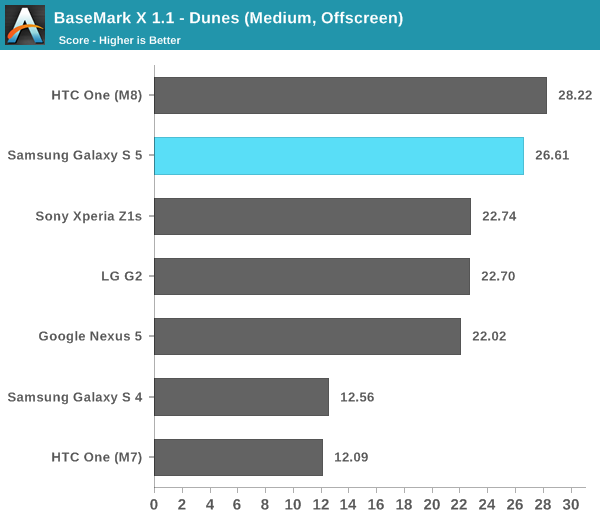
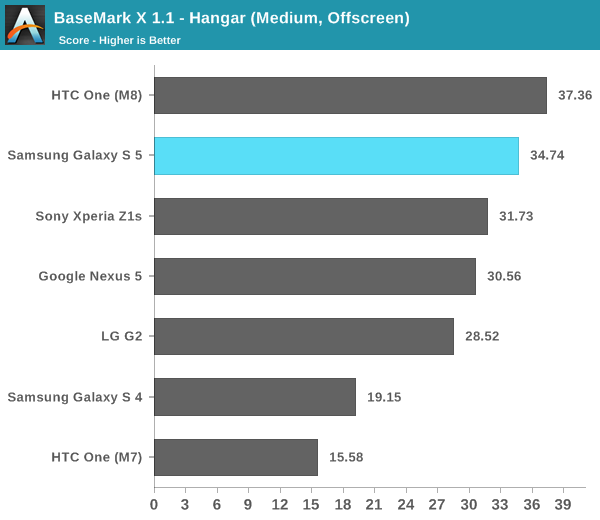

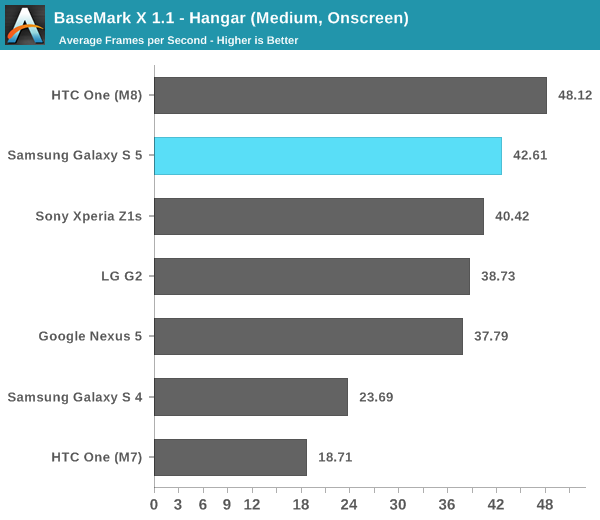
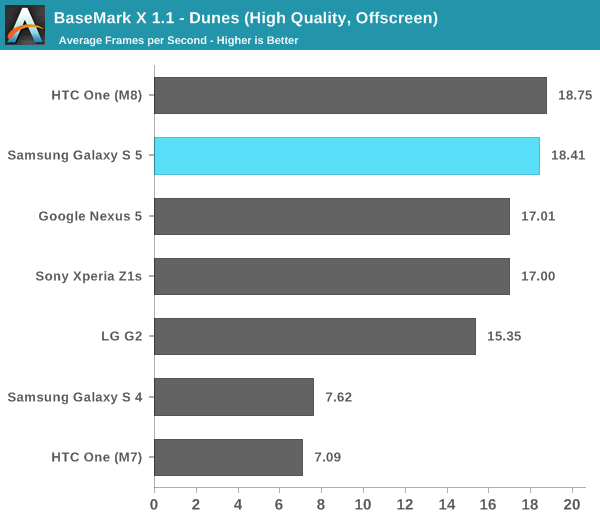
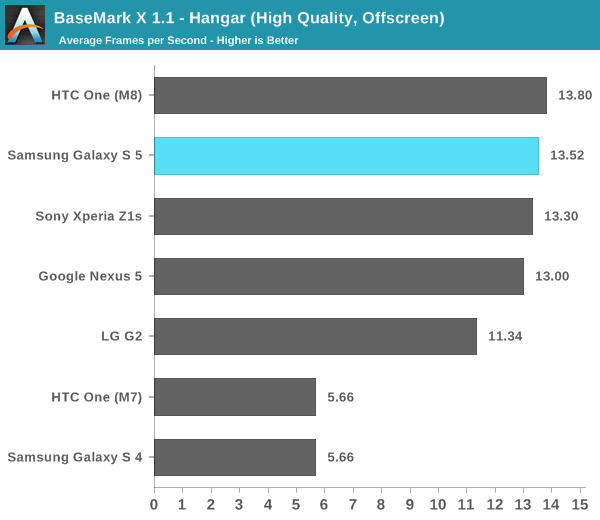
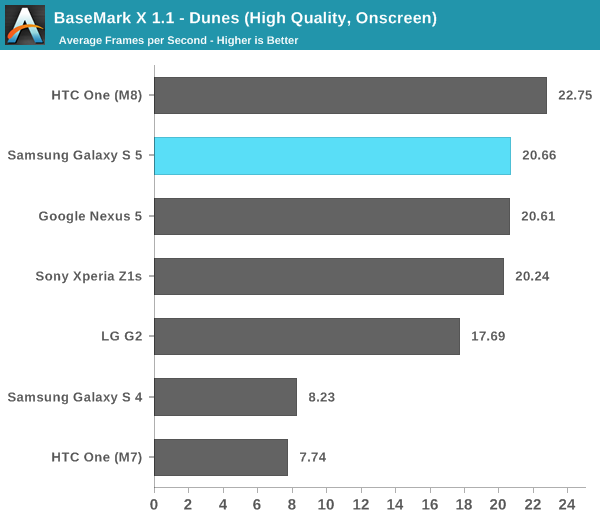
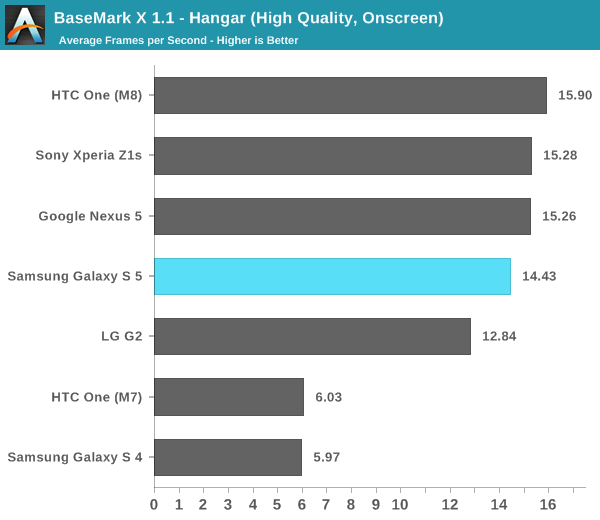
GFXBench 3.0
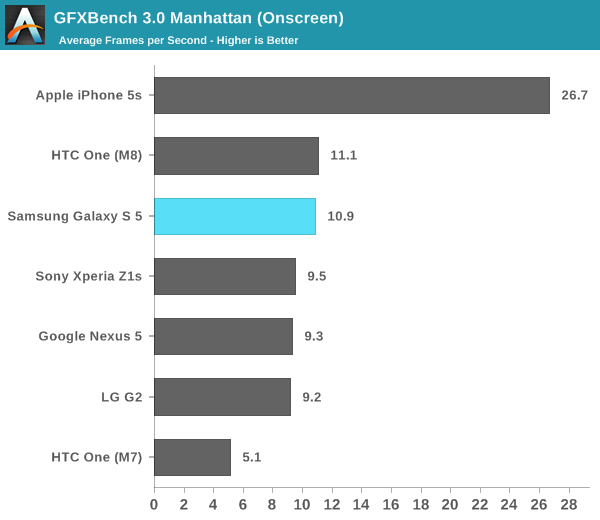
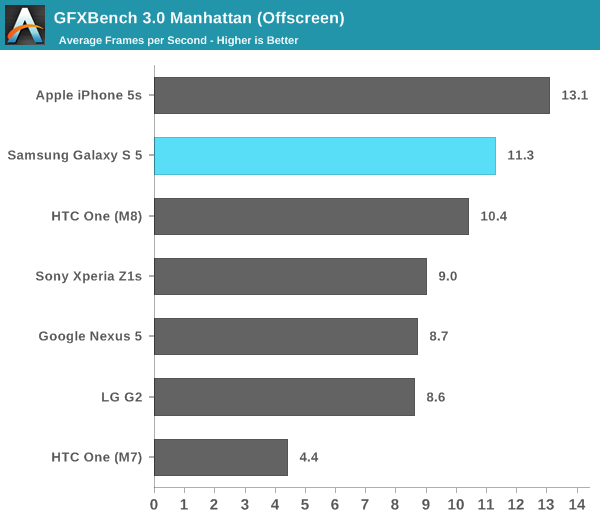
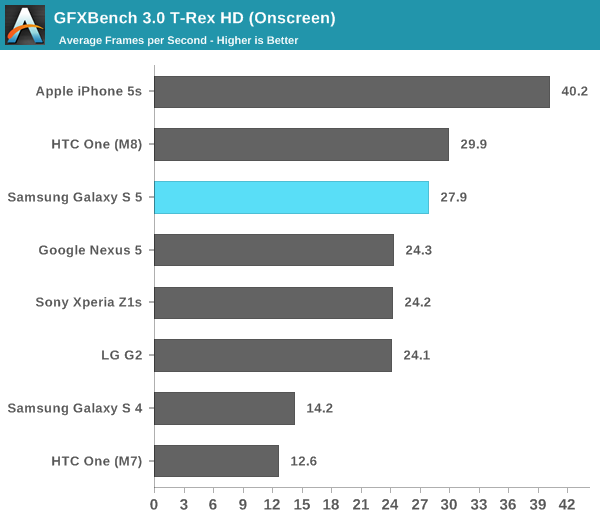
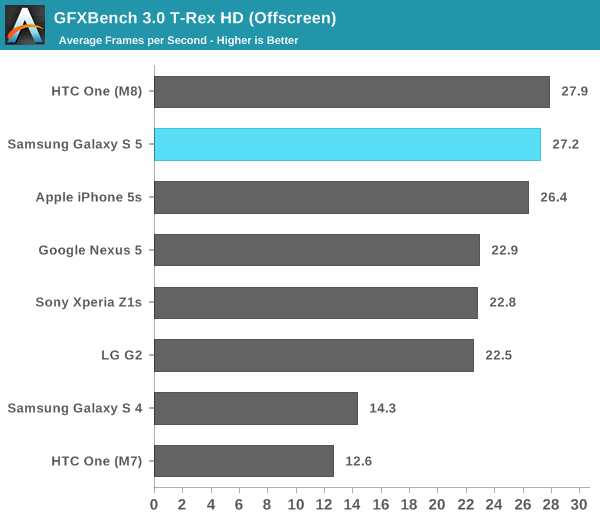

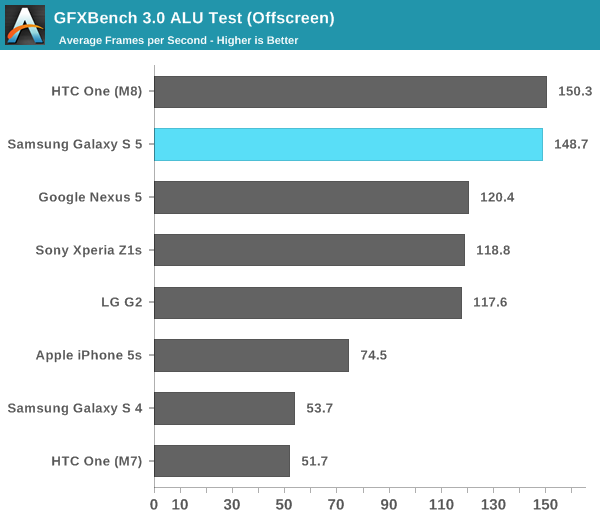


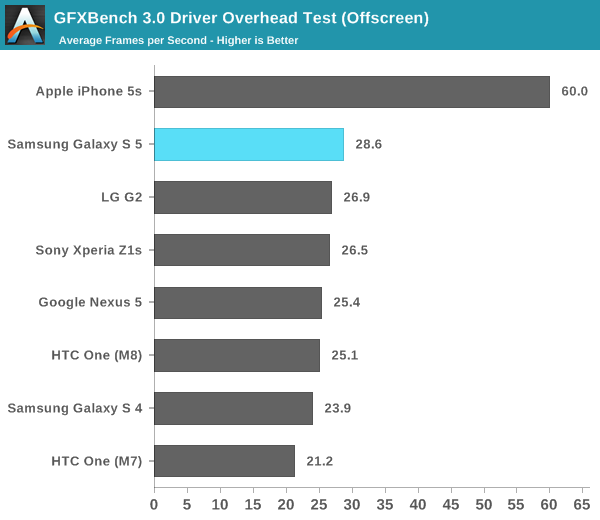
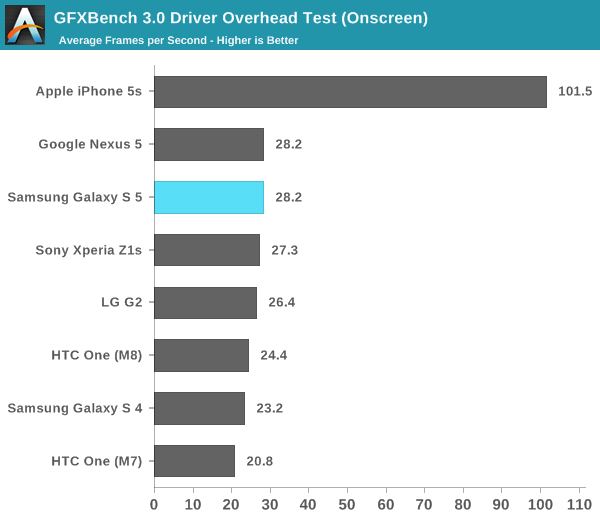
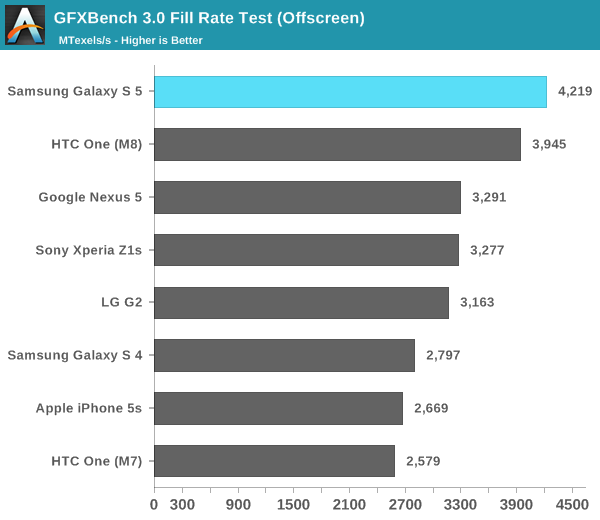
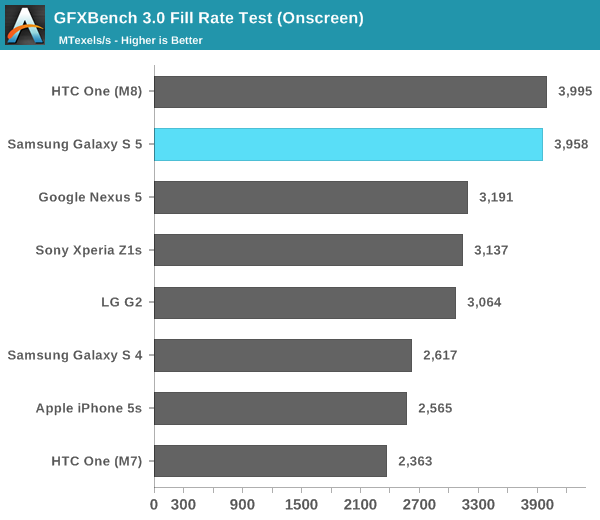
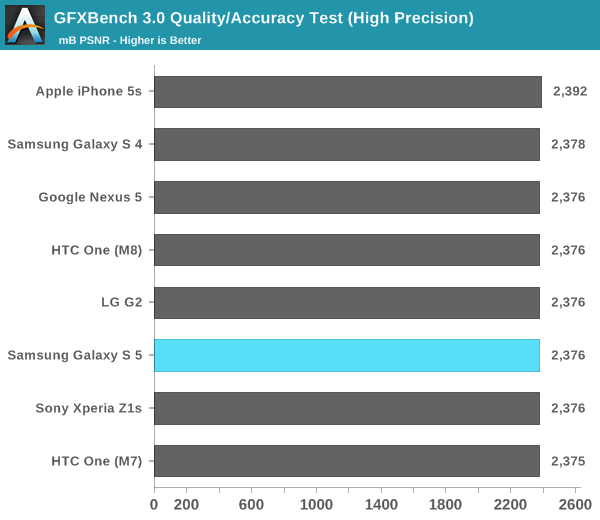
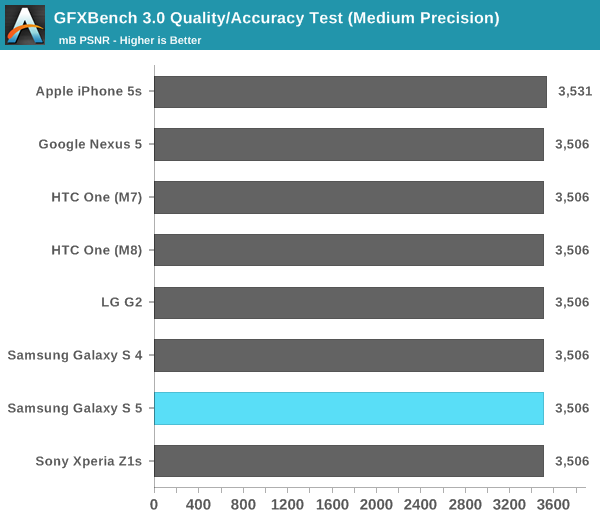
NAND Performance
The GS5 ships with 16GB or 32GB of NAND internally on an integrated eMMC device. Expansion is supported through a microSD card slot behind the removable back cover. Although the Snapdragon 801 inside supports eMMC 5.0, that alone doesn't guarantee a substantial increase in NAND performance. Keep in mind that most OEMs find multiple sources for their internal eMMC/NAND solutions, so what I'm testing here may only be representative of a portion of all GS5 devices.
Samsung sampled a 16GB GS5 review device. I put it through our usual random/sequential IO tests on a 100MB span of LBAs.
Random read performance is disappointing, it falls behind all modern devices we've tested. Random write performance is middle-of-the-road at best. It's unclear to me if this is a cost optimization or a lack of concern for NAND performance, but either way I'd rather see these metrics improve rather than regress.
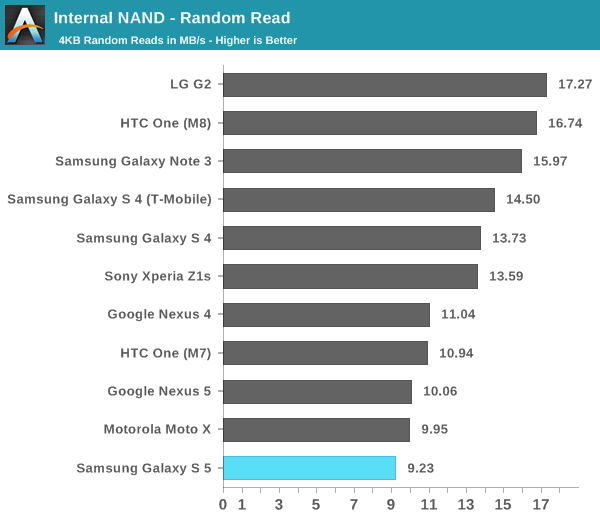
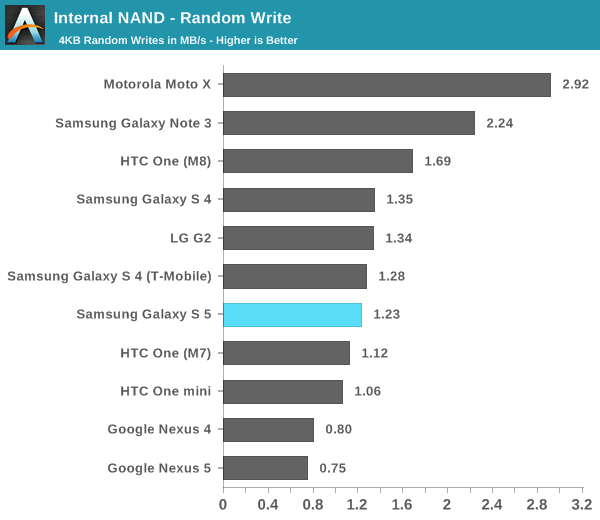
Sequential read/write performance both improve handsomely compared to the Galaxy S 4. I can see why Samsung would want to optimize for these two cases as they are quite common in regular usage, but random read/write performance can also significantly impact user experience.
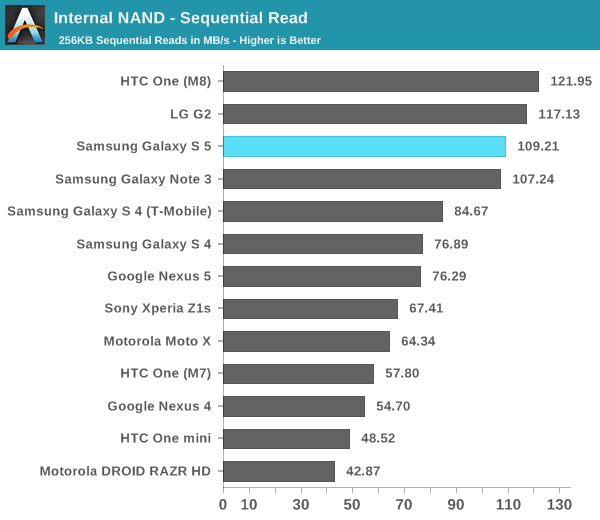
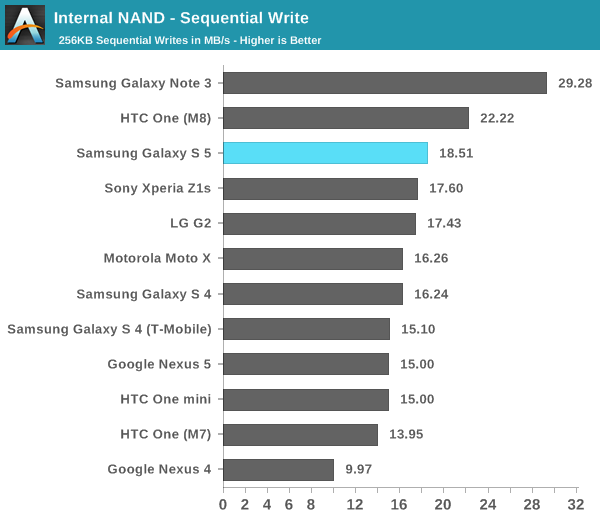










296 Comments
View All Comments
Alexey291 - Tuesday, April 8, 2014 - link
Well that's why it was nice to have an unlocked bootloader (in europe anyway - idk or care about US).Now with the advent of knox and the locked bootloader by default the galaxy brand looks less enticing.
Mondozai - Tuesday, April 8, 2014 - link
I don't why Anand is pretending that there is an open race out there.(Actually, I do, because how else to retain people's Interest?).The Nexus 5 (Black) wins on basically everything, especially software. It has no weak points, and it is by far cheaper than Z2/M8/S5. Sure, there are individuals areas, like metallic body for M8 that some prefer(although the notion thqt metql material = better, has become little more than conventional wisdom), but the total package is unbeatable.
Still, people are swayed by marketing, which is why Samsung can get away with charging 200 dollars too much. People are irrational.
nathanddrews - Tuesday, April 8, 2014 - link
"People are irrational."You're just learning this now? ;-)
Gigaplex - Tuesday, April 8, 2014 - link
No microSD, no sale. That rules out the Nexus 5 for me.miketh - Tuesday, April 8, 2014 - link
And can't swap batteries when this dies at end of long day.YuLeven - Tuesday, April 8, 2014 - link
Speak for yourself, Kemosabe. Nexus 5's lack of MicroSD and tiny battery is much more of a deal breaker to me than getting mad over dropped frames on the UI.Alexey291 - Tuesday, April 8, 2014 - link
It wins on everything except battery, sd card, not having to be google's ver. 4.x.0 guinea pig (because most people with nexus devices remember 4.2.0 and 3 months of misery that caused) a better screen (anand can screech and scream about "rgb gamut" or whatever but most people prefer pretty colours really ;) ) oh and better camera (one that works for one) decent touchscreen (one that works properly - I know multitouch is a new thing - one day it'll work on recent two nexus-es)... Oh and S5 is also waterproof... And the gpu is faster...But yeah nexus 5 wins on everything else. Mostly though on being cheap. *shrug*
Sushisamurai - Tuesday, April 8, 2014 - link
^ "the lags disappeared!", har har har. Reminds me of the time someone wanted the iPhone with the WIFI's.evilspoons - Tuesday, April 8, 2014 - link
I prefer accurate colours to ridiculous overblown colours any day. My skin, for example, is a pale pinkish-white colour, not oompa-loompa orange like the default settings on a lot of TVs and now smartphones paint it.comomolo - Tuesday, April 8, 2014 - link
You might want to learn a few things about the S5 screen: http://www.displaymate.com/Galaxy_S5_ShootOut_1.ht...You're welcome.